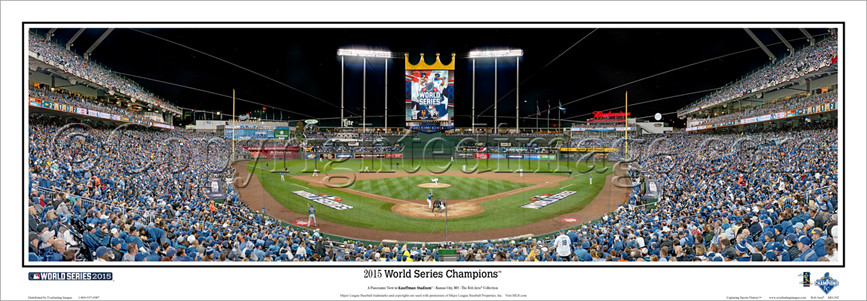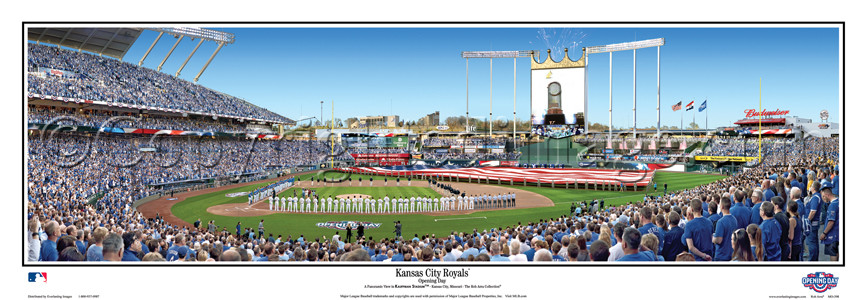It may be the fourth-oldest ballpark in the American League, but unlike every other stadium built in the 1960s and 1970s, the home of the Royals has remained one of the most picturesque ballparks in baseball. Opening in 1973, Kauffman Stadium broke from the trend of multi-purpose sports stadiums built across the country in the 1960s and 1970s for both baseball and football teams. Professional baseball arrived in Kansas City in 1955 when the Philadelphia Athletics moved to the city, playing at Kansas City Municipal Stadium. Originally constructed as a minor league ballpark in 1923, it was enlarged to accommodate the A’s. By the early 1960s, A’s owner Charlie Finley grew frustrated with the stadium and began looking for a new city to relocate his team.
In an attempt to keep the A’s in Kansas City, the Jackson County Sports Complex Authority was formed to acquire land and design a new sports complex for both the A’s and the Kansas City Chiefs (NFL). Initial plans called for a multi-purpose stadium, but those plans were abandoned due to design and seating capacity issues. Instead, the county decided to build two separate stadiums adjacent to one another: one for the A’s and one for the Chiefs. In June 1967, a $102 million bond was issued to finance the construction. However, Charlie Finley was unwilling to wait and moved the A’s to Oakland, California, in October 1967.
| MEMORABLE MOMENTS AT KAUFFMAN STADIUM |
|
After the A’s departure, U.S. Senator Stuart Symington demanded that Kansas City receive a new baseball franchise or he would introduce legislation to remove baseball’s antitrust exemption. In response, MLB decided to expand by four teams to start play in 1971. Kansas City was granted one of those franchises, the Royals. Due to pressure from Symington and other officials, MLB allowed the expansion teams to begin play in 1969 instead of 1971. Construction of the Truman Sports Complex, which would house both the Royals’ and the Chiefs’ stadiums, began on July 11, 1968. Originally known as Royals Stadium, the ballpark opened on April 10, 1973, with a seating capacity of 40,793. The stadium featured three tiers of seating in gold and orange, with all seats facing second base. The three-tiered seating deck stretched from the right field foul pole around home plate to the left field foul pole, but there was no seating in the outfield. The upper deck tapered into a single row near the foul poles. It was also the American League’s first ballpark to feature Astroturf as the playing surface.
One of the most unique features of the stadium was the water fountains beyond the outfield fence, a nod to Kansas City’s nickname as the “City of Fountains.” The fountains stretch 322 feet horizontally and feature a 10-foot-high waterfall cascading from an upper pool, which frames two fountain pools below. Additionally, a 12-story scoreboard in the shape of the Royals’ crest was located beyond center field.
The stadium remained largely unchanged until the 1990s. In 1990, a 30-by-40-foot Sony JumboTron video board was installed in left-center field. In 1993, the stadium was renamed in honor of Royals’ owner Ewing Kauffman, and two seasons later, the Astroturf was replaced with natural grass. After the 1998 season, Kauffman Stadium underwent a major renovation, which included the addition of Crown Seats, Dugout Suites, new clubhouses, and an exclusive restaurant and lounge known as the Crown Club. The orange and gold seats throughout the stadium were replaced with blue seats. In 2007, the Royals announced a two-year, $256 million renovation to further enhance Kauffman Stadium. Phase I, completed by Opening Day 2008, included the addition of new bullpens perpendicular to the field, an expanded Crown Club and Dugout Suites, and a new LED scoreboard in the left field wall. The most prominent change was the replacement of the original crown scoreboard in center field with a new 150-foot by 40-foot high-definition videoboard. Renovations also expanded concourses, improved the exterior of the ballpark, and created a 360-degree outfield concourse that allowed fans to walk all the way around the stadium. By Opening Day 2009, the renovation was complete. Additional upgrades included new fountain view terrace seating in the outfield and a host of new fan amenities, including a kids’ area called “The Little K,” a Taste of KC food area, a right field sports bar-themed restaurant, and the Royals Hall of Fame in left field. The ballpark’s seating capacity was reduced to 37,903 due to these changes.
Today, Kauffman Stadium remains a favorite destination for Royals fans from Kansas City, Missouri, Kansas, and beyond. The ballpark offers stunning views of the fountains beyond the outfield fence, as well as beautiful vistas of the surrounding Midwest landscape. Fans enjoy easy access to the stadium, with plentiful parking and multiple entrance points. Inside, circular ramps and escalators provide access to the upper levels, while the main concourse offers unobstructed views of the field. Fans in the field and dugout box seats must either walk through the dugout or field plaza seats or take the circular ramps. On hot days, many fans gather near the fountains in right field to cool down.
Though Kauffman Stadium is now one of the oldest stadiums in Major League Baseball, it remains one of the best. In early 2024, the Royals announced plans to build a new ballpark. As of January 2025, the Royals are still determining a potential site location and funding for a new facility.
After nearly three decades of rebuilding and losing seasons, the Royals returned to playoff baseball in 2014 for the first time since 1985, winning the American League Championship. Led by players like Mike Moustakas and Wade Davis, the Royals made back-to-back appearances in the World Series, and in 2015, they claimed the championship, defeating the New York Mets.


























